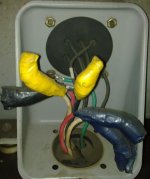Hi,
This is not PLC-related. Hope it's ok to post here. I've searched the forum but didn't find an answer.
I've searched the forum but didn't find an answer.
I work with several fully-hydraulic PIMMs (plastic injection molding machines). In a few months we plan to add a VSD to each machine with the purpose of electricity saving. The motors are 3-phase 380VAC induction motor. Unfortunately, not many people around us can provide informative answer. So we'd really appreciate your expert advice.
Some of the questions are :
1. Do we need to add a feedback encoder card to the VFD? If we don't, how does the VSD know when to change the frequency?
2. Do we need to add braking to the VFD in PIMM application?
3. How do we measure maximum load amps of the motor when used? There are six terminals on the motor cabinet, namely U1, V1, W1, U2, V2, W2. See picture attached.
Thanks a lot, guys!

This is not PLC-related. Hope it's ok to post here.
I work with several fully-hydraulic PIMMs (plastic injection molding machines). In a few months we plan to add a VSD to each machine with the purpose of electricity saving. The motors are 3-phase 380VAC induction motor. Unfortunately, not many people around us can provide informative answer. So we'd really appreciate your expert advice.
Some of the questions are :
1. Do we need to add a feedback encoder card to the VFD? If we don't, how does the VSD know when to change the frequency?
2. Do we need to add braking to the VFD in PIMM application?
3. How do we measure maximum load amps of the motor when used? There are six terminals on the motor cabinet, namely U1, V1, W1, U2, V2, W2. See picture attached.
Thanks a lot, guys!





